Buttoning a suit jacket correctly is more than a matter of personal style; it’s a reflection of etiquette and professionalism. Understanding the nuanced rules of suit buttoning can transform your appearance, making your attire look better and more refined. This guide will delve into the essential rules for jacket buttons, ensuring you present yourself impeccably in any formal or professional setting.
How Many Buttons Should a Suit Jacket Have?
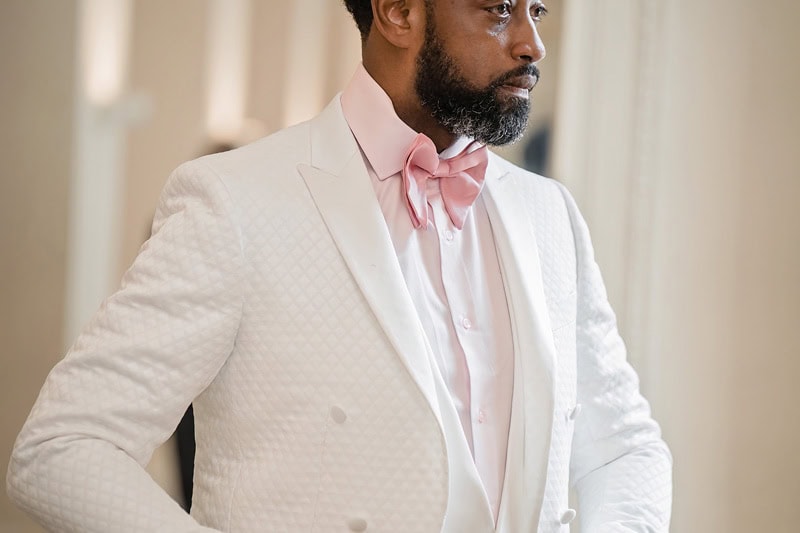
Understanding the Rule on the Number of Buttons
The number of buttons on a suit jacket can significantly affect its overall look and style. Traditional single-breasted suit jackets come with one, two, or three buttons, each offering a different level of formality and fashion. A two-button suit is considered the most versatile, suitable for both business and casual settings. Three-button suits lean towards a more formal and classic look, whereas one-button suits are typically reserved for tuxedos and high-fashion occasions. It’s crucial to choose a style that complements your fashion sense and the event you’re attending.
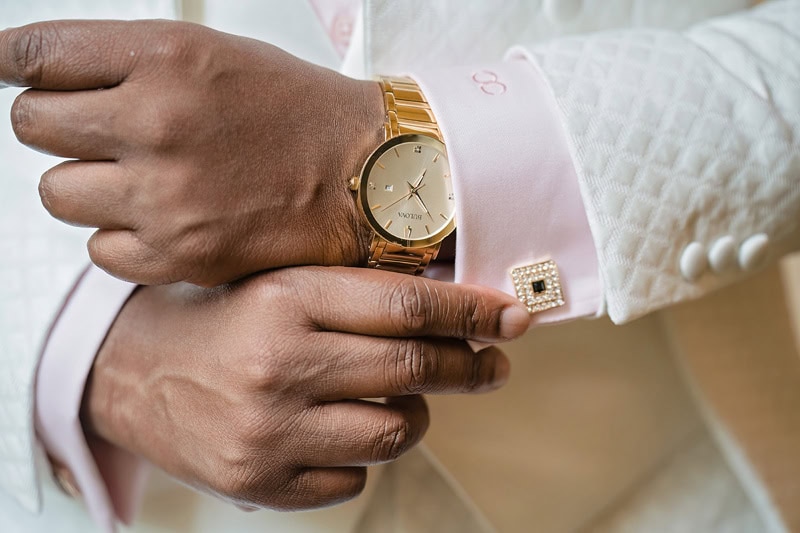
Notably, the choice between a one-button, two-button, or three-button suit jacket affects not just the aesthetic but also how the jacket should be buttoned to enhance your look. For instance, when wearing a three-button suit, the commonly accepted practice is to fasten the middle button always, the top button optionally, and the bottom button never. This guideline aims to balance the jacket’s proportions and ensure a flattering fit. Adopting these buttoning practices will ensure that you wear a suit with elegance and grace.
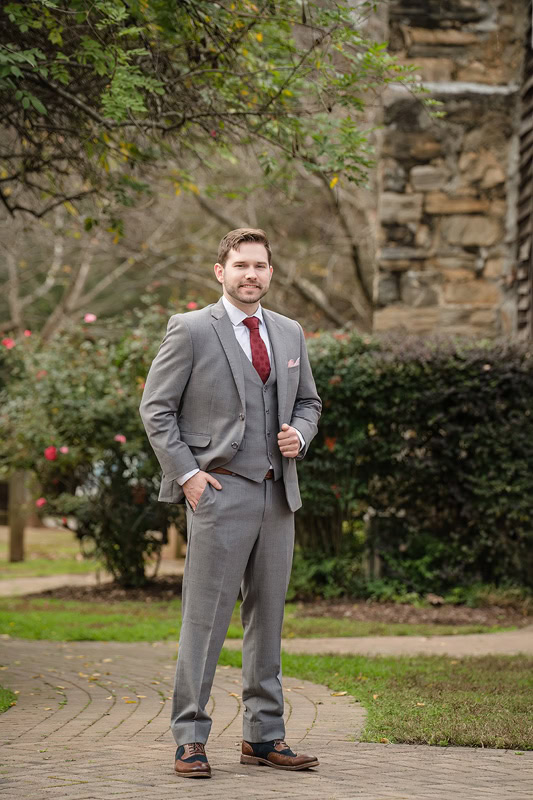
Single-Breasted vs. Double-Breasted Suit Jackets: Buttoning Guidelines
Single-breasted and double-breasted jackets offer vastly different silhouettes and buttoning guidelines. Single-breasted jackets, characterized by a single column of buttons, provide a streamlined look. The general rule here is simple: always leave the bottom button undone. This maxim is essential for creating an unbroken line that elongates the torso, enhancing the suit’s fit. On the other hand, double-breasted jackets feature a bolder, more pronounced look with two symmetrical rows of buttons. These should be kept fastened, even when sitting, to maintain their structured silhouette.
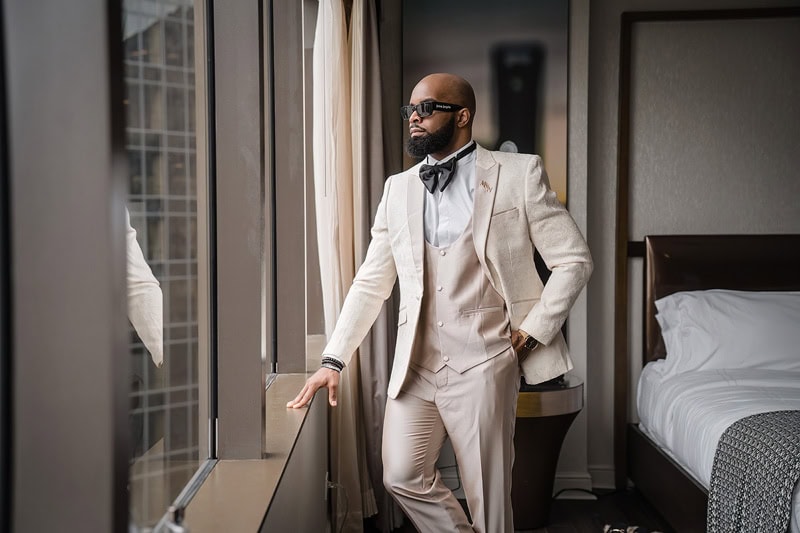
Double-breasted suit jackets, with their sharp lines and distinctive style, require strict adherence to buttoning rules to preserve their visual appeal. Unlike their single-breasted counterparts, the rule of thumb for double-breasted suits is to button all available buttons except the bottom one on each side. This practice ensures the jacket maintains its shape and proper drape over the body. Choosing between a single-breasted and a double-breasted jacket ultimately depends on personal style preferences and the occasion, but knowing how to button each correctly is key to pulling off the look.
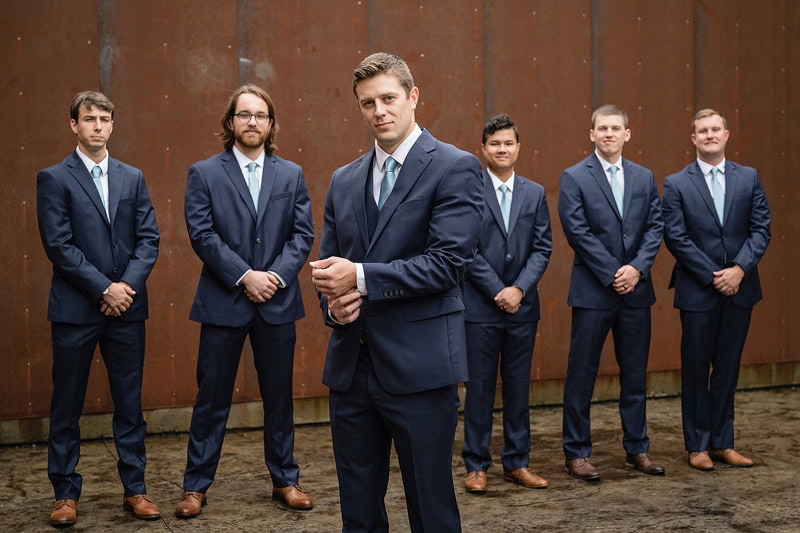
Where Should You Button Your Suit Jacket?
Deciphering the Bottom Button Dilemma
The curious convention of leaving the bottom button of a suit jacket undone stems from a mix of history and practicality. Originating from British royal fashion, the rule has evolved into a modern standard that aims to improve the jacket’s fit and allow for better mobility. When buttoning a suit jacket, fastening the bottom button can disrupt the garment’s tailored lines, causing it to pull awkwardly and detract from a clean silhouette. Therefore, adhering to this guideline not only honors sartorial tradition but also enhances the wearability and appearance of your suit.
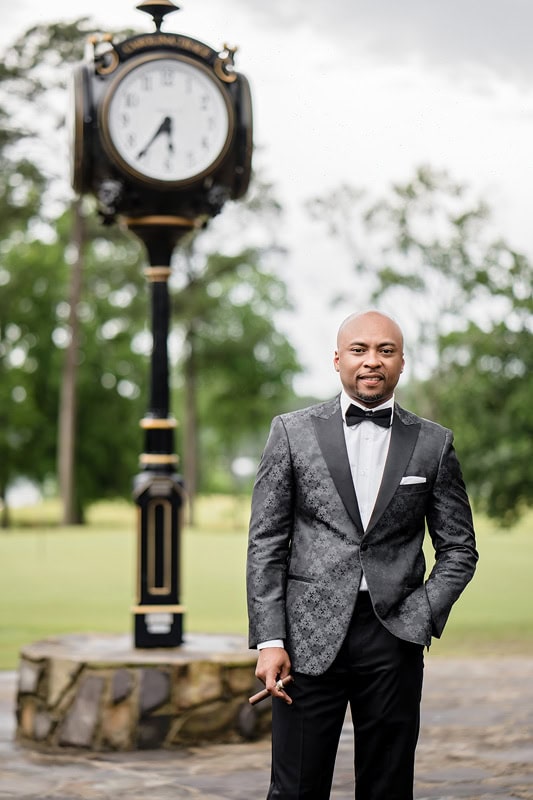
Understanding the rationale behind this button rule is crucial for anyone aiming to look better in a suit. Leaving the bottom button undone applies to all types of suit jackets, whether they are two-button or three-button designs. The only exception to this button rule is with a one-button suit jacket, where, naturally, the single button should be fastened when standing. This approach to buttoning ensures a harmonious balance between elegance and comfort, allowing the suit to drape naturally and flatter the wearer’s physique.

Properly Buttoning the Top Button for a Sleek Look
Buttoning the top button of a suit jacket can dramatically alter the garment’s look, pulling the lapels together and defining the chest and shoulders. For two-button suits, the top button should always be fastened when standing to uphold a sleek and composed appearance. This action creates a more fitted profile, emphasizing the suit’s structural design and the wearer’s form. However, it’s crucial to unbutton this top button before sitting down to prevent the jacket from straining and to allow for a comfortable range of movement.
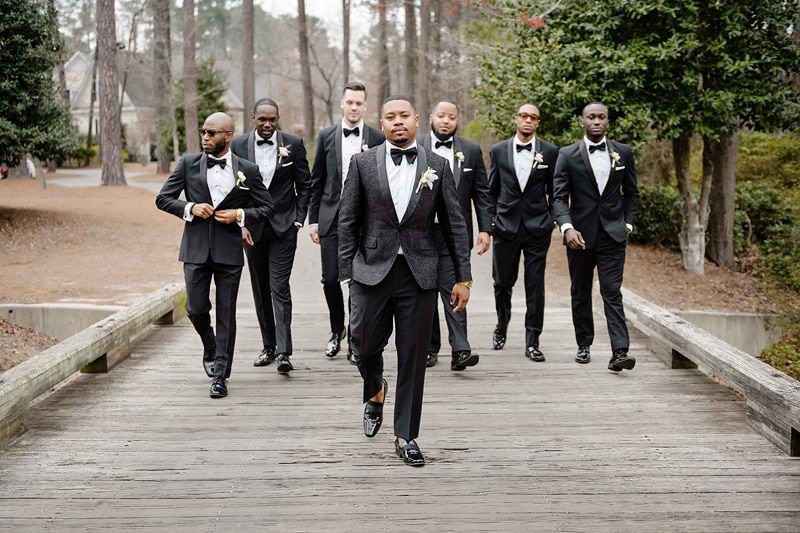
For those wearing three-button suits, the option to fasten the top button offers versatility in styling. Fastening the top button along with the middle one projects a more formal and traditional look, well-suited for professional environments or ceremonial occasions. It’s advisable to leave the top button unfastened in less formal settings for a relaxed yet polished appearance. Practicing these buttoning nuances with the top button can significantly impact your suit’s overall presentation, ensuring it complements your personal style and the setting.
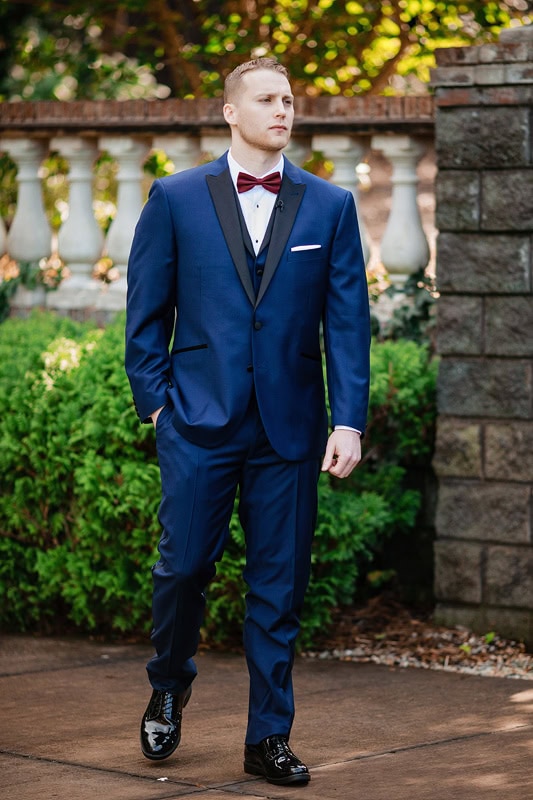
The Middle Button: To Fasten or Not to Fasten?
The middle button on a suit jacket holds a pivotal role in suit buttoning etiquette, serving as the keystone to a well-buttoned jacket. For suits with two buttons, fastening the middle (which, in this case, is the top button) is obligatory for a put-together appearance. This standard applies even more so to three-button suits, where the middle button should always remain fastened while the jacket is worn. The act of buttoning the middle button secures the jacket’s shape, ensuring it cinches slightly at the waist to accentuate the wearer’s silhouette.
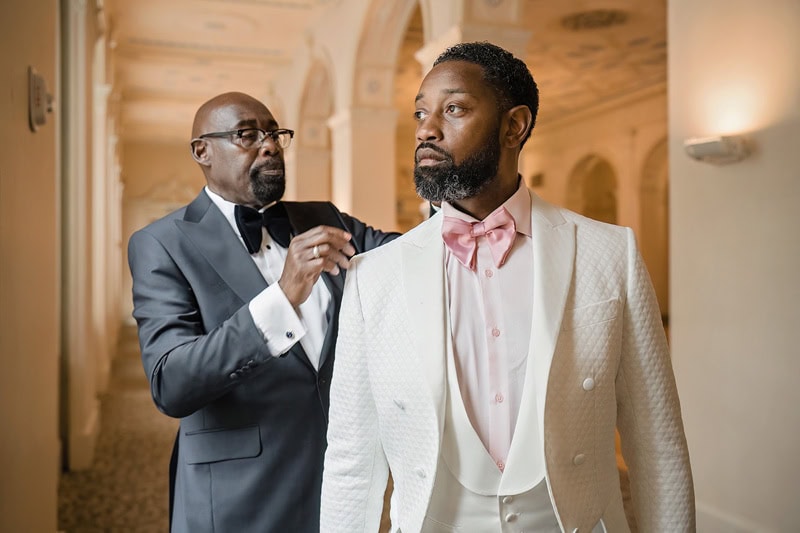
Adhering to this middle button rule is essential for achieving a polished and professional appearance. Whether it’s a business meeting or a social event, fastening the middle button can instantly elevate your look, making your suit appear more tailored and refined. This practice not only aligns with traditional suit-wearing etiquette but also supports the suit jacket’s design, allowing it to frame the body attractively. The middle button, therefore, is critical in maintaining the integrity and aesthetic of your suit ensemble.
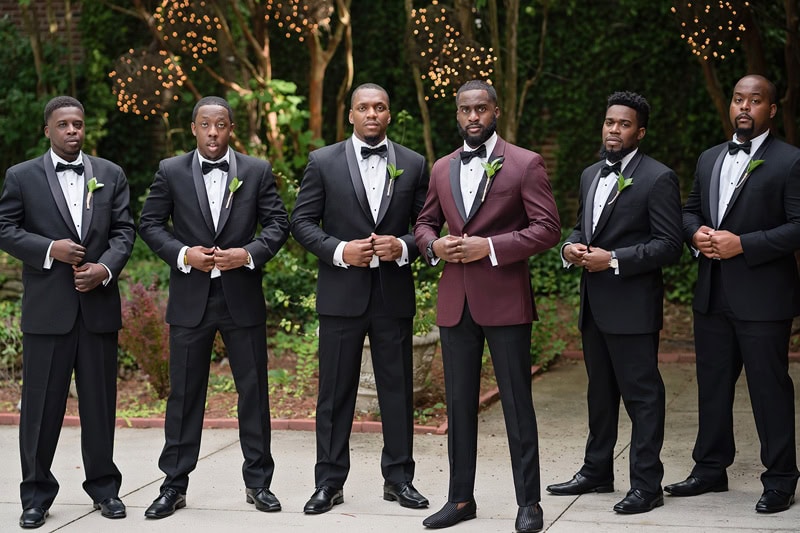
What are the Essential Suit Buttoning Rules?
The Golden Rule: Button Your Suit the Right Way
The golden rule of suit buttoning, “sometimes, always, never,” provides a simple yet effective guideline for managing the buttons on a three-button suit jacket. This mnemonic aids in remembering that the top button should sometimes be fastened (depending on the occasion and style preference), the middle button should always be fastened (to maintain the suit’s shape), and the last button should never be fastened (to allow for ease of movement and to preserve the suit’s fit). By following this rule, wearers can ensure their suit remains stylish and functional, adhering to the conventions of men’s fashion while flaunting a polished look.

The importance of this buttoning rule lies in its ability to adapt the suit to various body types and settings, making it a fundamental principle for any well-dressed individual. Whether attending a formal event or a casual meeting, understanding and applying the “sometimes, always, never” rule can greatly influence your presentation and comfort. This guideline not only enhances the suit’s aesthetic appeal but also caters to practicality by accommodating movement and preventing the fabric from bunching or stretching awkwardly.
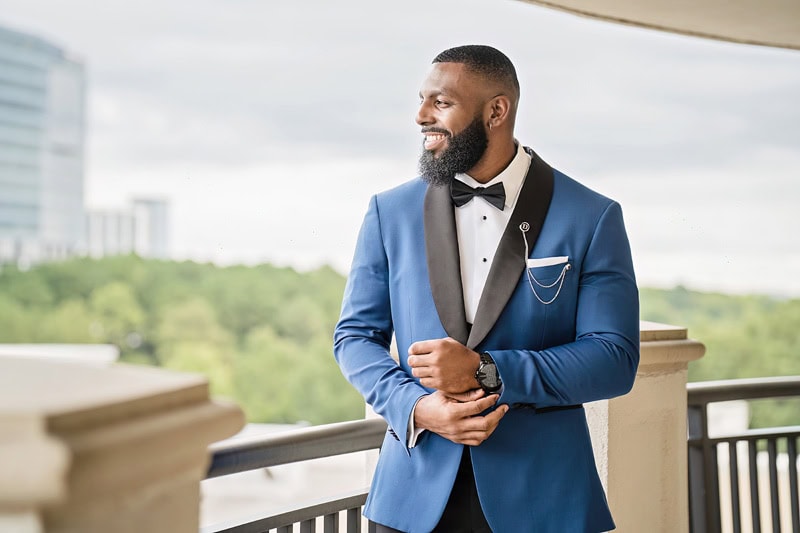
Note: Early in my wedding photography career, Jerry Ghionis taught me this differently. He taught “always, maybe, and never.” I’m still a personal fan of this for the style of jackets I typically wear and see in modern wedding attire. More on this below.
Mastering the Three-Button Suit Jacket: Dos and Don’ts
Navigating the specifics of a three-button suit jacket requires a good understanding of when and how to utilize each button for an optimal appearance. The cardinal rule of “sometimes, always, never” is paramount, guiding wearers on the appropriate use of each button. Additionally, keeping the jacket buttoned while standing and unbuttoned while sitting is essential for maintaining a sharp look and ensuring the suit’s longevity. This practice prevents the fabric from stretching out and keeps the suit looking crisp and well-fitted over time.
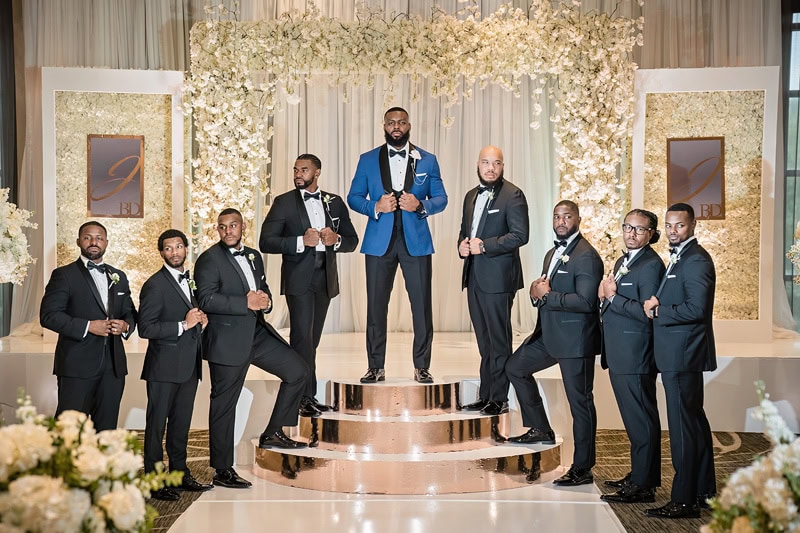
Another key aspect of mastering a three-button suit jacket is the consideration of the suit’s cut and the wearer’s body type. For individuals with taller frames, fastening the top button in addition to the middle one can enhance the suit’s proportionality, elongating the silhouette. Conversely, those with shorter or stockier builds might find leaving the top button undone creates a more balanced and flattering appearance. Experimenting with these buttoning options and observing their effect on the suit’s overall look can help determine the most flattering approach for different body types and occasions.

Unbuttoning: When is it Acceptable to Unbutton Your Jacket?
Unbuttoning a suit jacket at the appropriate times is just as crucial as knowing when to button it. The general guideline dictates that the jacket should be unbuttoned when sitting down to prevent pulling and wrinkling of the fabric, ensuring the suit remains in pristine condition. This practice not only aids in comfort but also in preserving the suit’s structure and appearance over time. When standing up, re-fastening the buttons restores the suit’s polished look and should be done promptly.
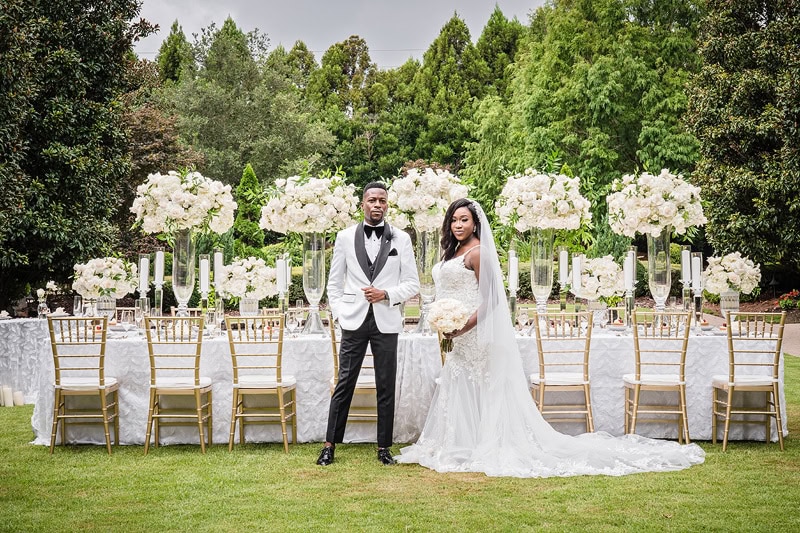
Moreover, unbuttoning the suit jacket can be a strategic move in less formal or more social settings, signaling a transition from strictly business to casual or relaxed interactions. This subtle shift can significantly alter the wearer’s perceived approachability and demeanor. However, it’s vital to gauge the formality of the occasion and the cultural expectations surrounding suit-wearing etiquette before deciding to unbutton. Being mindful of these nuances ensures that the act of unbuttoning is both appropriate and beneficial to one’s presentation.
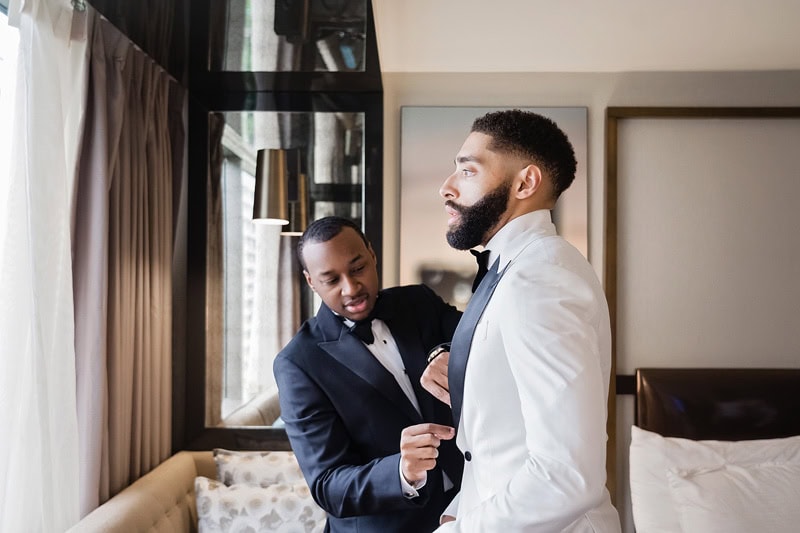
How to Button a Double-Breasted Suit Jacket?
Navigating the World of Double-Breasted Suits: Buttoning Techniques
Double-breasted suit jackets, with their distinctive design and additional buttons, require a different approach to buttoning than their single-breasted counterparts. The key principle is to keep the jacket buttoned at all times, even when seated, to maintain its structured look. This rule accentuates the double-breasted jacket’s unique silhouette, ensuring it always appears sharp and tailored. Typically, all the buttons should be fastened except for the bottom one, mirroring the practice of leaving the bottom button undone on single-breasted jackets.
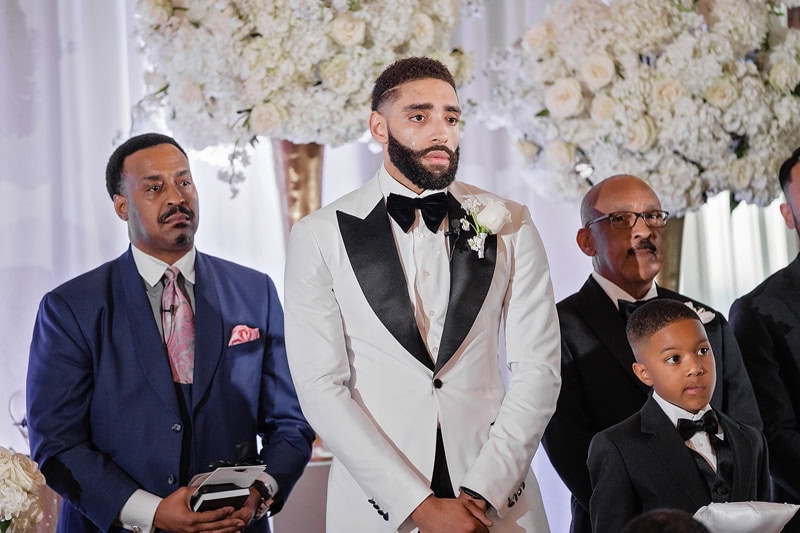
The strictness of this buttoning rule underscores the formal nature of double-breasted suits, which are often chosen for their elegance and statement-making qualities. Adhering to these buttoning techniques enhances the suit’s aesthetic appeal, reinforcing its authority and sophistication. For those opting for a double-breasted style, understanding these buttoning practices is essential for leveraging the suit’s full potential and achieving an impeccable look.
Never Button the Bottom Button: Myth or Truth?
Exploring the Tradition of Not Buttoning the Bottom Button

The advisement to never button the bottom button of a suit jacket is deeply rooted in menswear tradition, transcending mere fashion whimsy to become a cornerstone of suit-wearing etiquette. This guideline serves multiple purposes: it preserves the suit’s clean lines, allows for better movement, and adheres to historical fashion norms. While it might seem like a small detail, adhering to this practice can significantly impact the overall look and comfort of the suit, demonstrating an awareness of style nuances and respect for sartorial customs.
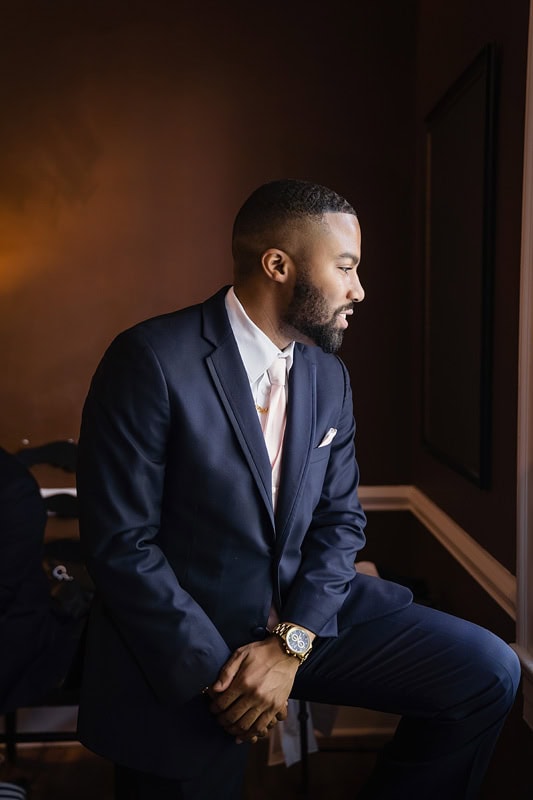
Despite its seemingly arbitrary nature, the rule to leave the bottom button undone is based on practical and aesthetic considerations. It accommodates the natural stance and movement of the body, preventing the suit from bunching up or distorting. This convention is universally recognized among well-dressed men and is a testament to the enduring values of classic menswear. By embracing this tradition, wearers not only ensure their suits fit and look better but also pay homage to a time-honored aspect of men’s fashion.
Q: What is the fundamental rule for buttoning a suit jacket?
A: The fundamental rule for men’s suit button rules is that if you have a single-breasted suit, you should always fasten the middle button when standing and, optionally, the top button, but never the bottom. This practice helps to create a shape that enhances the suit style.
Q: How should you button a double-breasted jacket?
A: When wearing a double-breasted jacket, keep all the buttons fastened, including the lower button, both when standing and sitting. This maintains the structured silhouette that double-breasted jackets are designed to offer.
Q: Are there any exceptions to suit jacket button rules for a three-button suit jacket?
A: Yes, for a three-button suit jacket, the generally accepted rule is “sometimes, always, never.” This means you may button the top button, but you should always button the middle button, and never button the last button. This method helps maintain balance and proportion in your suit look.
Q: What is the proper way to button a single-button suit jacket?
A: The single-button suit jacket is the simplest in terms of rules. You should keep the button fastened when standing to preserve a sleek and closed silhouette. It’s customary to unbutton your suit jacket when sitting down to avoid straining the fabric.
Q: Is it ever appropriate to button all the buttons on a suit jacket?
A: In traditional and modern men’s suit button rules, it is almost never appropriate to button all the buttons on a suit jacket. For single and double-breasted jackets alike, keeping the bottom button undone is a standard practice to ensure a better fit and allow for movement.
Q: How does buttoning your suit jacket correctly affect its appearance?
A: Correctly buttoning your suit jacket according to established jacket button rules can significantly affect its appearance. Proper buttoning can create a flattering silhouette, define your waist, and ensure the jacket drapes nicely, making your suit look better overall.
Q: When is it appropriate to leave your suit jacket unbuttoned?
A: It is appropriate to leave your suit jacket unbuttoned when sitting down to prevent the fabric from pulling and to ensure comfort. Additionally, in more casual settings, leaving the jacket unbuttoned can create a laid-back, approachable look. However, for formal occasions or when first meeting someone, keep your jacket buttoned while standing.
Q: What should be done with the jacket buttons when wearing a waistcoat?
A: When wearing a waistcoat under your suit jacket, the general rule is to button the waistcoat fully but always keep the bottom button of the suit jacket undone. This combination offers a sharp, tailored appearance while adhering to traditional suit jacket button rules.
